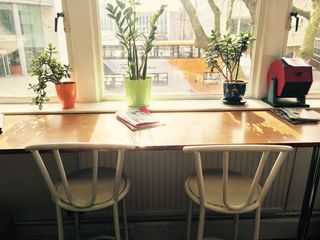
Career
Ninja-Proof Seats
Where you sit at work can impact your productivity.
Posted August 27, 2019 Reviewed by Lybi Ma

I once worked in an office full of software engineers who were obsessed with what they called ninja-proof seats. A ninja-proof seat is one with its back to the wall so you can be sure no ninjas can sneak up from behind. Setting aside questions of whether ninjas can fly or climb walls, your computer screen can’t be seen without your knowledge.
Our original office was an industrial conversion in New York City’s West Village, although it wasn’t really converted for office use. It was a small sail-making factory that a flamboyant man named Franz had fitted out with Grecian columns and internal balconies, before running off to Berlin and subletting it to our organization. This meant there were many internal walls and small spaces. In the largest room, the software developers had arranged their desks in a large U so that everyone could have a ninja-proof seat.
As the organization grew, we needed to move to a larger, more professional office. The new space was lovely, with outstanding amenities like a living green wall, well-stocked kitchen, and expansive views. The company was vying to attract top engineering grads, wooing them with a workplace they would never want to leave.
But as you often find with these Google-esque offices, lots of energy had been put into these eye-catching extras, and much less into the workstations themselves. It was essentially a large, open-plan office with long rows of desks down the center.

And this meant there were no ninja-proof seats! Not a single one. The developers’ complaints were dismissed as irrelevant—except for the most fearsome socks-under-Birkenstocks-wearing coder, who was mysteriously allowed to claim a broom closet for his sole use. (In hindsight, he may possibly have had a reputation for being more productive than all of the other developers combined.) The HR team was convinced that ninja-proof seats were mainly good for getting away with playing video games at work.
The term “ninja-proof seat” may be used primarily by those fluent in Python and JavaScript, but you will find people who are adamant about their need for one in any office you go to. This is because they provide what geographer Jay Appleton called refuge and prospect.
If you imagine a time when we were being chased by lions or men with swords, certain places would be much safer than others. Climbing up a hilltop would allow a good prospect of approaching threats. Building a fort against a mountain face would be even better, as it would provide refuge and limit the directions from which these lions or pirates might attack you.

Ideally, we desire environments that offer us the ability to observe potential threats and opportunities (prospect) without being seen by said threats and opportunities (refuge). Appleton argues that these evolutionary preferences were major factors in determining the environments humans have historically selected for settlement, the ways we modify geography and lay out parks, and artistic representations of idealized natural landscapes.
Our preference for ninja-proof seats works on the same principle. Many people feel most comfortable and at ease when they have their back to the wall rather than an open room or door. Next time you walk into a half-empty café, look around and see which seats are taken. Those backing against walls and facing windows or doors almost always fill up first.
More importantly, however, we can actually concentrate better on our work and demonstrate increased cognitive performance in ninja-proof seats.
Research from the Swedish University of Agricultural Sciences has suggested that natural environments providing this coveted sense of refuge are the most restorative spaces for people suffering from stress (Grahn & Stigsdotter, 2010).
In the office environment, workers with a pleasant view or prospect outdoors have been found to be 6-12 percent more productive than workers without one. The same study found that office workers with a good view performed 10 percent to 25 percent better in terms of mental function and memory recall when compared to their unlucky counterparts working without window views (Heschong, 2003).

Of course, not every seat can optimize refuge and prospect at the same time—choosing a seat backing the wall may also mean facing away from a window.
As an environmental psychology consultant advising businesses on how to design their workspaces for greater well-being, I’ve noticed that many workers exhibit a higher preference for one or the other. Those seeking refuge, like the software engineers I worked with, tell you they simply can’t function with people walking up behind them. Prospectors will do anything to get a prime spot with a window view.
So what does this mean for enhancing your productivity—and protecting yourself from those pesky ninjas—at work?
- Employees: Are you a refuger, or a prospector? Think about where you feel most productive and whether your current desk supports that.
- Homeworkers: Position your desk in a place that gives you a nice view outside, but also a sense of enclosure.
- Designers and office managers: Office layouts often don’t optimize refuge and prospect simply because no one has thought to do so! Take a look at how workstations are laid out in your office, and consider rearranging them to create some ninja-proof seats.
This post is adapted from my book, The Shaping of Us: How Everyday Spaces Structure Our Lives, Behavior, and Well-Being.
LinkedIn Image Credit: WAYHOME Studio/Shutterstock
References
Appleton, J. (1996). The Experience of Landscape, (Rev. ed.). New York: John Wiley.
Grahn, P. & Stigsdotter, Grahn, P. & U. K. (2010). The Relation Between Perceived Sensory Dimensions of Urban Green Space and Stress Restoration. Landscape and Urban Planning, 94, 264-275.
Heschong, L. (2003). Windows and Offices: A Study of Office Worker Performance and the Indoor Environment. California: California Energy Commission.



